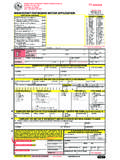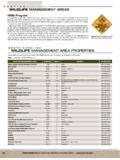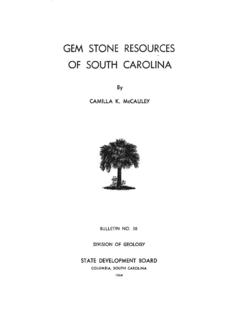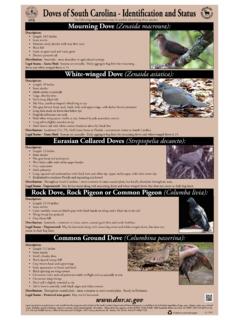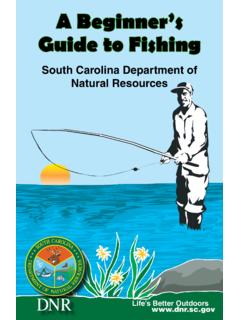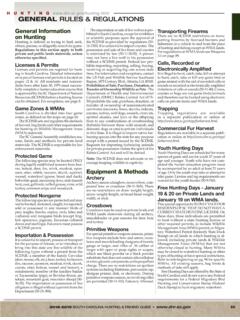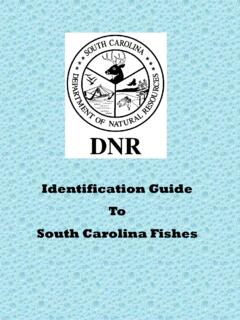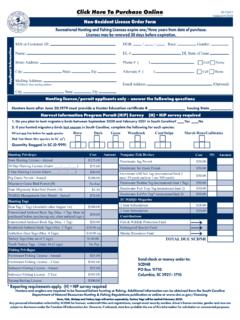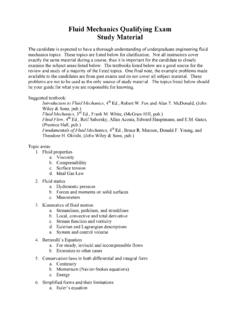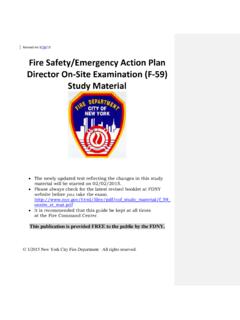Transcription of 2018 Envirothon Topic Reference, Soils Study Material
1 SoilsSC EnvirothonCoaches WorkshopColumbia, SCFebruary 6, 2016 Objectives Define SC s Major Land Resource Areas Define soil Define various soil properties Discuss the soil survey/web soil survey/soilweb Define soil healthMajor Land Resource Areas(MLRA)ColumbiaGeologyMetamorphic rocks:granite gneiss, schistSoilsloamyEdneyvilleSaludaGreenvil le Caesar's Head Pickens Table Rock MountainArea: 2% of stateElevation: 1,200-3,554 Land of WaterfallsOconee -Jocassee Falls EdneyvilleArea: 32% of stateElevation: 400-1,200 Soilsdeep, red, clayeyCecil, Applinghigh shrink-swellIredell, BrewbackGeologyIgneous and metamorphic rocks:granite, gneiss, diabaseSedimentary rocks:siltstone (Triassic Basin, Chesterfield)Berry Gully -Before Berry Gully -After Spartanburg County; 1933 Site of 1stSES erosion controlproject in the southeastern Piedmont landscapeIredellCecilArea: 15% of stateElevation: 200-600 Lee Co.
2 Sand Hills landscape, eolian dunesAileySoilssandy to fine-loamyAlpin, AileyAlpinGeologyEolian sandsAncient river depositsWeathered claysArea: 50% of stateElevation: 0-640 DothanRainsSoilssandy to clayeywell drained to very poorly drainedDothan (well drained)Rains (poorly drained)GeologyMarine depositsRiver depositsRains landscapeDothanlandscapeMedium for plant growthRecycling system for nutrients and organic wastesSystem for water supply and purificationHabitat for soil organismsEngineering mediumWhat is Soil?The Ideal SoilSoil Forming Factorstimeclimateparent materialtopographyliving organismsSoil HorizonsMaster Horizons O horizon (organic) predominantly organic matter (litter and humus) A horizon (mineral) zone of organic matter accumulation (topsoil) E horizon (mineral) zone of eluviation (loss of clay, Fe, Al) B horizon (mineral) zone of accumulation (clay, Fe, Al, CaCO3, ) --subsoil forms below O, A, or E horizon C horizon (mineral) little or no pedogenic alteration, unconsolidated parent Material , soft bedrock R horizon (rock) hard, continuous bedrockSoil TextureSoil TextureSoil Texture = % Sand, Silt, & Clay Soil texture is the single most important physical property of the soil.
3 Knowing the soil texture alone will provide information about: water and nutrient holding capacity water movement soil mechanics suitability/potentials for many ag and non-ag uses homes, nitrate leaching, P Index, septic suitability, stormwater runoff,..Terry Cooper, Univ. of MinnesotaSand mm -2 mm Visible without microscope Feels gritty Sand grains usually quartz if sand looks white or many minerals if sand looks brown Some sands in soil will be brown, yellow, or red because of Fe and/or Al oxide coatings Considered non-cohesive does not stick together in a mass unless it is very wet Low specific surface area Sand has less nutrients for plants than silt and clay Voids between sand particles promote free drainage and entry of air Holds little water and is prone to droughtTerry Cooper, Univ. of MinnesotaSilt mm mm Not visible without microscope Floury feel smooth like silly putty Quartz often dominant mineral in silt since other minerals have weathered away Wet silt does not exhibit stickiness, plasticity, malleability Smaller particles retain more water for plants and have slower drainage than sand Easily washed away by flowing water highly erosive Holds more plant nutrients than sand Silt trivia Yellow River in China gets its name from the erosion of loess, a high silt materialTerry Cooper, Univ.
4 Of MinnesotaYellow RiverClay < mm Flat plates or tiny flakes Small clay particles are colloids if suspended in water will not settle Large surface area spoonful will cover a football field Wet clay is very sticky and plastic Easily formed into long ribbons Pores spaces are very small and convoluted movement of water and air very slow Water holding capacity tremendous capacity to adsorb water; not all available for plants Shrink swell none to considerable depending on the type of clay Soil strength and shrink/swell affects buildings, roads, and foundations Chemical adsorption is largeSEM of smectiteTerry Cooper, Univ. of MinnesotaSoil Textural Classes --USDAC ombinations of sand, silt, and clay clay clayTextureFlowchartSoil Color Most easily determined soil property Important characteristic in separating soil horizonsColor chartsUniversal standard for soil YR 4/3 Number and letter symbols represents the represents the dominant color of the soilNotation is at the top right of the color bookY=Yellow, R=Red, G=Green, B=Blue, YR=Yellow RedMunsell YR 4 / 3 The number before the slash is the Value.
5 Lightness of a color. 0=pure black; 8=pure white. Notation at left side of color book. Intensity of a color. 1=less intense; 8=most intense. Notation at bottom of color number after the slash is the is Color Important? Infer soil characteristics such as: drainage class organic matter content provenance of soil (where it came from) Color is affected by: organic matter content the higher the organic matter content, the darker the soil oxidation/reduction state of the soil presence of Fe orange, red, yellow, brown absence of Fe graySoil StructureWhat is Soil Structure? arrangement of soil particles into aggregates Individual units are called a PEDS (Latin, earth)Why is Structure Important? Influences water movement aeration porosityimportant indicator of soil healthSoil Structure TypesGranularPlatyBlocky(Angular)(Subang ular)WedgeColumnarPrismaticSoil TaxonomyIts all to , kaolinitic, thermic Typic KanhapludultsSoil Taxonomyis the basic system of soil classificationfor making and interpreting soil Classify?
6 -Show relationships-Remember properties-Establish groups for various purposes and uses-Develop new knowledge and relationships-Communication for the discipline of soil scienceSoil Orders in South Carolina Entisols little development, usually A-C horizons Inceptisols little more development, Bw horizons Alfisols argillic/kandic horizon (Bt) less than 2 m, base saturation is > 35% Ultisols argillic/kandic horizon (Bt) less than 2 m, base saturation is < 35% Mollisols dark, high organic matter, high native fertility Spodosols spodic horizon (Bhs), high in subsoil Fe/Al and/or humus Histosols organic soils06 AAApACgEntisolsInceptisolsAlfisolsUltiso lsSpodosolsMollisolsHistosolsfeetAC1 BwCBtCBtAEBhsBwOeOaCBtgBuncombeEdneyvill eIredellCecilSantee*Leon*Clingman**Coast al PlainC2C3**Great Smoky NPSoil SurveySoil Mapping or SurveyingSoil mappingis a method to inventory the differenttypes of Soils in a survey up of 3 Parts Soil Maps Soil Descriptions Suitability RatingsWeb Soil Survey Wed-based version of the soil survey All SC counties are available, as well as most counties in the Soil SurveyArea of InterestSoil Map/Soil DescriptionsSuitability RatingsSuitability RatingsSuitability RatingsSoil WebAppSoil HealthBattle Starts HereWhat is Soil Health?
7 Once referred to as soil quality Defined as how well a soil does what we want it to do Bountiful crops and forests Productive grazing lands Clean air and water Diverse wildlife Beautiful landscapesFour Basic Soil Health Principles Use plant diversity to increase diversity in the soil Manage Soils more by disturbing them less Keep plants growing throughout the year to feed the soil Keep the soil covered as much as possibleWhat s Critical about Soil Health Now? World population projected to increase to >9 billion by 2050 Between 1982-2007, 14 million acres of prime farmland in the US were lost to development Improving soil health is the key to long-term, sustainable agricultural productionWhat Are the Benefits of a Healthy Soil? Healthy soil holds more water (and loses less water to runoff and evaporation) Organic matter builds as tillage declines and plants and residue cover the soil Organic matter holds 18-20 times its weight in water and recycles nutrients for plants to useWhat Are the Benefits of a Healthy Soil?
8 One percent of organic matter in the top six inches of soil would hold approximately 27,000 gallons of water per acre! Most farmers can increase their soil organic matter in 3 to 10 years if they are motivated about adopting conservation practices to achieve this Carolina Soils are variable but with the right planning, these Soils can meet our needs without damaging or destroying END
